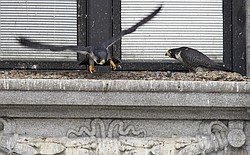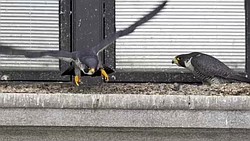Falcons’ roost is county’s boost
Peregrine Falcon Nest

Peregrine Falcon Nest at the Mahoning County Courthouse, Youngstown, OH.
Peregrine Falcon Nest

Peregrine Falcons nest on a 4th floor window ledge of the Mahoning County Courthouse in Youngstown, OH.
Falcon Facts
Peregrine falcons were on the federal endangered species list until 2006.
Peregrine falcons suffered near annihilation after the introduction of the synthetic pesticide DDT during World War II. The chemical substance interfered with egg production. As a result, in 1965, no peregrine falcons were hatched in the eastern or central U.S. DDT was banned in 1972.
The first peregrine pair to inhabit Ohio’s cities was discovered in the 1980s, residing in a Toledo skyscraper. The birds’ choice of stony nesting sites parallels canyons, their natural habitats.
They normally grow to 15 inches in length with a 40-inch wingspan.
They can fly as fast as 175 mph.
Females are larger and more powerful than males. Adults have slate dark blue-gray wings and backs barred with black, pale undersides, white faces with a black stripe on each cheek, and large, dark eyes. Their wings are long and pointed.
Their prey include ducks, pheasants, pigeons and small birds.
Prey is caught in flight. The falcon delivers a powerful blow to its prey with a half-closed foot. It retrieves the dead bird either in mid-air or after it falls to the ground.
Source: Vindicator Files
A nest of peregrine falcons on the courthouse will save Mahoning County the expense of pigeon removal.
VINDICATOR STAFF WRITER
YOUNGSTOWN — Mahoning County is blessed with natural intervention to solve the perennial problem of pigeon overpopulation at the county courthouse — at no cost to the taxpayers.
This intervention, in the form of a new fourth-floor peregrine falcon’s nest, couldn’t have come at a better time as the county faces a budget crunch that makes artificial interventions less affordable.
A state wildlife biologist, Damon M. Greer, visited the courthouse Thursday and confirmed that the window-ledge nest outside the law library contains three peregrine falcon eggs being incubated by an adult female.
“I am excited to hear that, especially if they’re helping us in a natural way with pigeon control,” said Kathi McNabb Welsh, chief deputy clerk of courts.
She called the peregrines a green solution “to something that was an unpleasant issue at the courthouse.”
“In these tough financial times, when we’re finding that our funds are low, this kind of help from above is very cost-efficient,” she added.
The nest is in a sheltered recess at the top of the colonnade on the courthouse’s front facade.
Greer, assistant wildlife management supervisor for the Ohio Department of Natural Resources, said he expects the eggs, which have up to a 33-day incubation period, will hatch in mid- to late June, with the young birds making their first flights about six weeks later.
Greer said he believes the nesting pair of adult birds at the courthouse is the same pair that nested for several years on top of the 12-story Stambaugh Building and made a failed nesting attempt earlier this year near the top of the 17-story Metropolitan Tower building.
The falcons, which typically live 10 to 12 years in the wild, catch all of their prey in mid-air, Greer said.
“While they do eat pigeons, it’s not the major part of their diet. They eat smaller birds also,” Greer said. “They’re going to have some impact and likely going to deter the pigeons from being here,” he said while viewing the peregrines’ nest.
Greer, who monitors peregrines in Northeast Ohio, said ODNR plans to place metal identification bands on the legs of the chicks and continue to monitor them and the adults.
If all the eggs hatch, “There’ll end up being five falcons here,” he noted. “Five falcons can obviously eat more than two, so they may have an additional deterring effect on the pigeons and other birds,” including starlings and sparrows in downtown Youngstown, he said.
“It’s not a real big bird, but they have very sharp, fast swooped-back wings that allow them to dive very quickly,” he said. “They’re built more like a fighter jet than a commuter aircraft.”
The Mahoning County Courthouse nest is one of 15 confirmed peregrine falcon nests in northeast Ohio. Most are in the Cleveland area; others are in Akron and Canton.
As for the fourth floor location of the Mahoning County Courthouse nest, he said: “It is rather low. Typically, we expect them to nest at 10 stories or above. ... They will choose whatever location they can.”
“This is a relatively undisturbed site, so they’re able to, hopefully, successfully nest there,’’ Greer said.
The parents will continue to feed and train their young to hunt for three to four weeks after their first flight, Greer said. “By the end of August, they’ll pretty much be on their own.”
The problem of excessive numbers of pigeons, their droppings, and the smelly and unsanitary conditions created by them had long been complained about by employees of the clerk of courts’ office, who recently noticed a sharp decline in the courthouse pigeon population.
About 15 years ago, the county installed netting to discourage pigeons from inhabiting the courthouse facade, but only the tattered remnants of that netting are visible today.
Mark Stan, chief steward for American Federation of State, County and Municipal Employees Local 3956, which represents deputy court clerks, said the netting was effective for five or six years after its installation.
Periodically the county has hired a tanker truck with a hose to suction the pigeon droppings from the facade of the century-old building. In one instance, the truck was called after pigeon droppings blocked a drain, Stan recalled.
“It was very dirty outside the windows,” and people entering and leaving the courthouse risked being struck by pigeon droppings, Welsh said.
Stan said he has noticed many fewer pigeons outside the courthouse windows and less pigeon excrement on the courthouse steps in recent weeks.
Stan said he’d like to see the county re-install the pigeon netting after this year’s peregrine nesting season ends. He said he wants it installed over all areas of the courthouse facade, except the peregrine nesting site, to which he hopes the peregrines will return next year.
“I’m just glad Mother Nature took over where the county couldn’t handle it,” Stan concluded.
milliken@vindy.com
 43
43
